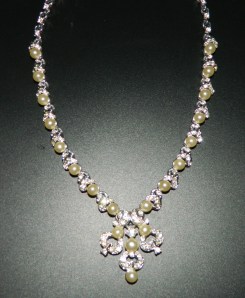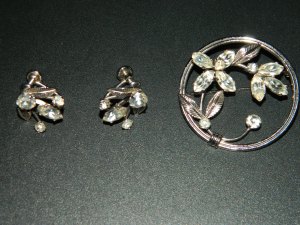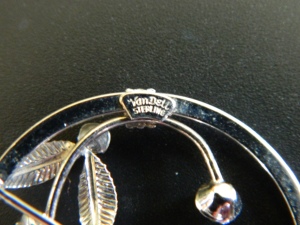The term ‘costume jewellery’ was initially used in the early 20th century to describe imitation jewels and gems that fashion designers would create to complement their clothes, hence costume jewellery.
They were made from inexpensive materials such as glass, base metals and plastic. Although thought of a modern invention due to their mass production, this type of inexpensive jewellery can be traced back through to ancient times, from the Egyptians, through the middle ages, and medieval times.
In the early 18th century there was a greater prosperity within the middle classes who wanted to dress to impress, diamonds were, however, extremely expensive and relatively scarce. The solution was a new glass imitation – paste. This hard brilliant glass could be cut and polished to produce ‘gems’ with a convincing sparkle. The most stylish pieces were bold and extravagant, some jewels were spring mounted and swayed when you moved. Examples of which can be found in the jewel room at the V&A quivering as you walk past!
Around 1720 ‘Pinchbeck’ (named after Christopher Pinchbeck) came into being an alloy of copper and zinc that successfully mimicked gold, and retained its colour without tarnish, it could also be worked and decorated in the same way as gold. The formula was widely imitated by other manufacturers and it remained popular until it gradually became replaced by rolled gold and other gilt metals.
These early discoveries led onto other technological advances and over the centuries a number of jewellery styles emerged which embraced the costume jewellery ethos. Unlike much of the costume jewellery available today these pieces were exquisitely made by highly skilled craftsmen. They were often quality pieces which despite their intrinsic value stood the test of time and are still valuable and fashionable today!
When the United States entered World War II, base metals such as brass were rationed which led many of these costume jewellery manufacturers to start using sterling silver in their ranges. An example of this is below in this 1940s brooch and earring set by American brand VanDell.
In the 1940s and 1950s Hollywood glamour came to town and a number of costume jewellery brands began making mass market statement pieces, early examples often imitating precious Art Deco jewels, this heralded the era of the ‘cocktail style’ and we still use the term ‘cocktail ring’ to describe a big, bold, bling ring; usually inexpensively made.
A number of jewellery manufacturers from this era are now highly collectable names in the vintage jewellery market, and we will look at a few of these designers in a future post…


